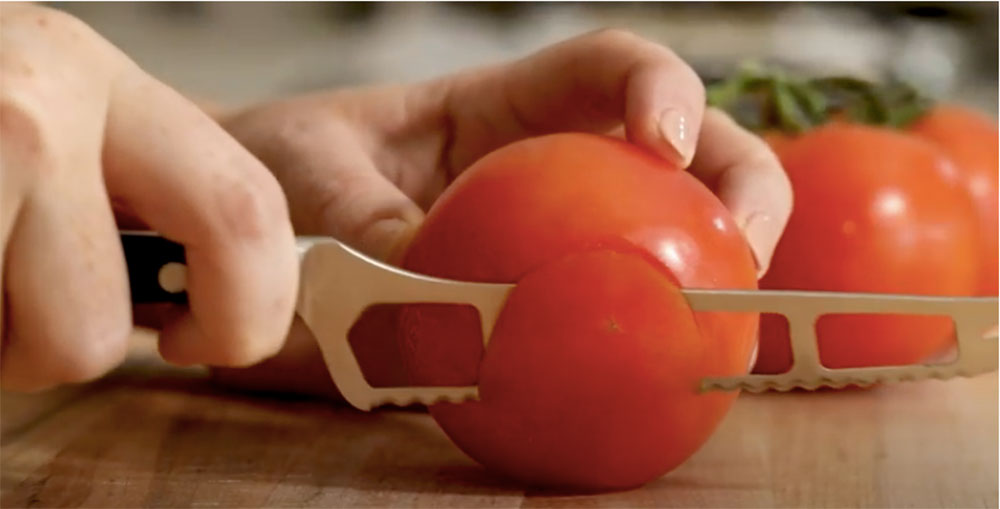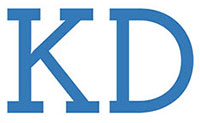
Above and on the front from the Messermeister website.
By Nancy Pollard
After owning one of the best cooking stores in the US for 47 years—La Cuisine in Alexandria, Virginia—Nancy Pollard writes Kitchen Detail, a blog about food in all its aspects—recipes, film, books, travel, superior sources and food-related issues.
 JOE RAFFA WAS La Cuisine’s knife skills instructor and executive chef for José Andrés’s Think Food Group for a decade. He has declared a small collection of useful but not overly elaborate knives the most important tools in your kitchen other than your hands. Amen. And as we Cuisinettes sharpened thousands of knives, cleavers, even some switchblades over the decades, we learned to detect a few things about the quality of a knife’s construction.
JOE RAFFA WAS La Cuisine’s knife skills instructor and executive chef for José Andrés’s Think Food Group for a decade. He has declared a small collection of useful but not overly elaborate knives the most important tools in your kitchen other than your hands. Amen. And as we Cuisinettes sharpened thousands of knives, cleavers, even some switchblades over the decades, we learned to detect a few things about the quality of a knife’s construction.
Like seeing “Solingen” on a blade. Solingen is the Detroit of cutlery, and there are hundreds of knives to get confused over, ranging from excellent to disposable. Add to this, heaps of inaccurate marketing hype that inflates the value of knives from other manufacturers. We checked consumer guides and magazines, talked to chefs and butchers, and came away with a few selections. Even the most highly marketed ones, sold in every type of store except 7-11 came up short against this one company: Messermeister.
Bernd Dressler: Listener and Innovator

The late Bernd Dressler, founder, with his wife, of Messermeister.
The story of Messermeister, which means Knife Master, starts with its founder, with whom we conversed several times. Bernd Dressler emigrated from Germany to Austrialia and then to the US. He worked with other knife companies until he had enough experience to forge (no pun intended) his own knife venture with his wife, Debbie, in 1981. He chose a three-generation-old knife-making family in Solingen and worked with them to produce a joint vision of hand-crafted and beautifully engineered knives. At this time, several techniques were in wide use in both Germany and France that faked the traditional drop-forge production of chefs’ knives, thereby lowering the cost of said knives. The most sophisticated technology was sinter metal component technology (SCT).
SCT was used by a few highly marketed German knife brands and was, to my mind, no more than a fancy way to market a cheaper knife at an astonishingly high price. Instead of utilizing the hot-drop and hammer-forging knives in one piece—which is expensive—the knives were being made in three pieces: much cheaper to produce. The three pieces were then “frosted” with an alloy so that they look as if they are single-forged. We noticed a distressing difference when we sharpened these knives: Foremost was the inability to hold an edge. Most manufacturers in Germany were wise enough to have dropped SCT in their knife production, but it is in wide use in China.
Through his in-depth conversations with professional chefs, Bernd engineered some major innovations in manufacturing kitchen knives. Some of Bernd’s innovations are now copied by many knife manufacturers. In technical terms, he created the bolsterless heel with an unusual camber and a more refined angle for the blade’s cutting edge. His invention was a semi-bolster and a camber on the edge, replacing a full vertical bolster with a flat camber. In simple terms, his ideas reduced the awkwardness and made cutting more efficient. He also reduced the cutting edge to 15 degrees instead of the 20+-degree angle, and this significantly improved slicing. Bernd lengthened the handle and designed a greater slant at the heel. You’ll feel how much more comfortable the pinch grip is from Bernd’s sloping design in the bolster. Even the palm grip is more comfortable with his re-engineering of the handle. It just feels and cuts better than anything else you’ve ever used.
Messermeister Expanded Selections Today
Built on the foundation established by Bernd and his brother Bruen, Messermeister is currently owned entirely by Bernd’s widow and two daughters. They have expanded the brand to include culinary tools, knife accessories, and a selection of Asian knives. I can tell you that their tools are a better quality than many produced by competing brands with fancy ergonomic handles and lousy blades.

Knife guards from Messermeister.
We always carried the San Moritz series because of its really comfortable, somewhat longer molded handle. This series also has a nifty monogram plate in the handle. Their Edge Guard knife shields are clearly the best in the field. Easy to slip on and off, they don’t crack with use, and the knives in your kitchen drawer can easily be slipped in and out of the shield.
The Meridian series has the same quality blade as the San Moritz but with a less expensive handle. Their Four Seasons series is cheaper stamped knives. Take a look at their Stealth Knife, again one of  Bernd’s innovations after the popular rise of the Santoku blade. In keeping with the desires of some knife aficionados, Messermeister produces a series of beautiful knives with Italian olive wood handles and with California Burl Walnut.
Bernd’s innovations after the popular rise of the Santoku blade. In keeping with the desires of some knife aficionados, Messermeister produces a series of beautiful knives with Italian olive wood handles and with California Burl Walnut.
You may be interested in their selection of Japanese knives, which for the quality are quite reasonably priced. They are made with an AUS steel alloy and heat-treated to 59 HRC (Rockwell Hardness). Both the truly authentic Japanese knives with a single bevel, and some modified Western versions are available too. Handles on these are shaped in the Japanese traditional bamboo or Micarta-style material. All of this spells quality.
Check Their Website for Stores or Purchase Online
Whether you go through a local dealer or purchase directly from the manufacturer, you will find Messermeister a remarkably responsive company to deal with. The firm offers free ground shipping on orders over $85, and they send out special offers and word of new products to their subscribers. Go to the bottom of their website for knife-sharpening information, maintenance instructions, and helpful guides in choosing knives that suit your needs.
To start, you should have a large chef’s knife and a smaller paring knife. Size should be determined by what feels comfortable in your hand, not by what you see some food personality slinging on TV. Get yourself a honing steel, too, and use it after each knife chore. It is, as I often said in the shop, similar to flossing your teeth: hard to initiate, but repetition makes a good habit.
On a personal note, the Messermeister forged tomato knife and bread knife are indispensable tools in my kitchen. And I am not a hoarder of kitchen gadgets.


